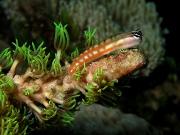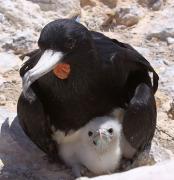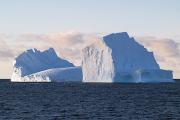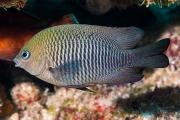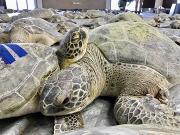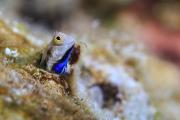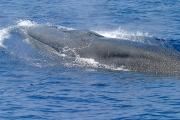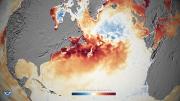Radio Program
Our regular Science and the SeaTM radio program presents marine science topics in an engaging two-minute story format. Our script writers gather ideas for the radio program from the University of Texas Marine Science Institute's researchers and from our very popular college class, Introduction to Oceanography, which we teach to hundreds of non-science majors at The University of Texas at Austin every year. Our radio programs are distributed at to commercial and public radio stations across the country.
Fish display an amazing array of colors. Some are blacker than charcoal, others have rainbow-colored stripes, and still others have a mottled appearance to help them blend into the background. And the variety extends to fish eyes. They can feature colorful specks, dark stripes, and irises from red to green. Some even shine in the dark.
The recent saga of life on Ascension Island is a series of miscalculations. When the island was first settled, in 1815, it was a haven for millions of birds. But colonists also brought rats, which overran the island. So the settlers brought in cats to eat the rats -- which they did. But the rats and cats also ate the birds and their eggs. That decimated the birds, driving at least one species to extinction. But the cats were eliminated a decade ago, so the birds are coming back.
You might not think that the way an iceberg melts would matter much -- but it does. As an iceberg melts, the change in ocean temperature and salinity can alter currents and have other effects. So scientists need to know how and how quickly icebergs melt to make sure their ideas of how the oceans work are accurate.
Researchers in Australia recently contributed to that effort with experiments and mathematical models. Their work showed that icebergs don’t all melt the same way.
The longfin damselfish is a feisty little farmer. It’s only a few inches long, but it will attack just about anything that enters its territory -- including people. Yet some damselfish in the Caribbean actually protect a tiny shrimp on their farms. That’s because the shrimps’ waste helps fertilize the farm -- which may make the damselfish stronger.
The South Padre Island Convention Centre has hosted conferences, plays, concerts, and even basketball games. In February, though, it hosted an event like no other: a sea turtle rescue.
For the humpback whales of Glacier Bay, Alaska, the early months of the COVID-19 outbreak may have been a blessing. Travel bans and cancelled cruises left the bay much quieter, especially during the summer tourist season. That meant the whales didn’t have to “talk” as loudly or simplify their messages as much as they do during normal summers.
In fact, for several months the oceans got much quieter. As economies closed down, the number of cargo ships went down, too. Scientists monitored what was going on -- both at the shipping noise and at how marine creatures responded.
The smallest fish in the oceans grow fast and die young. And that may keep coral reefs going. The little guys are known as cryptobenthic fish -- crypto for “hidden,” and benthic for “ocean floor.” They’re no more than a couple of inches long, and most of them are much smaller. So that allows them to “hide” among the corals.
Most islands don’t move around much. But for more than two decades, scientists and others operated from one that did. Known as T-3, the kidney-shaped island was seven miles long. It drifted close to the north pole. And eventually, it melted away. That’s because the island was made of ice -- it was a giant iceberg.
T-3 was discovered after World War II, when the military was sending airplanes across the Arctic Ocean to keep an eye on the Soviet Union. In 1952, the Pentagon built a station on the island to record the weather.
One of the most endangered groups of whales in the world hangs out in the northeastern corner of the Gulf of Mexico. It’s down to fewer than a hundred members. And although it’s protected as an endangered species, challenges in the Gulf could make it hard for the whale to recover.
One of the adages of modern science is that if a butterfly in China flaps its wings, it might lead to a hurricane weeks later in the Atlantic Ocean. There’s no way to prove or disprove that idea. But there does seem to be some evidence of a connection going the other direction: Warmer water in the northwestern Atlantic may be one factor in creating heatwaves over China, Korea, and Japan.
Eastern Asia has undergone several deadly heatwaves in recent years. A month-long hot spell in 2018 broke a century-old record in Korea, with temperatures reaching 105 degrees.

